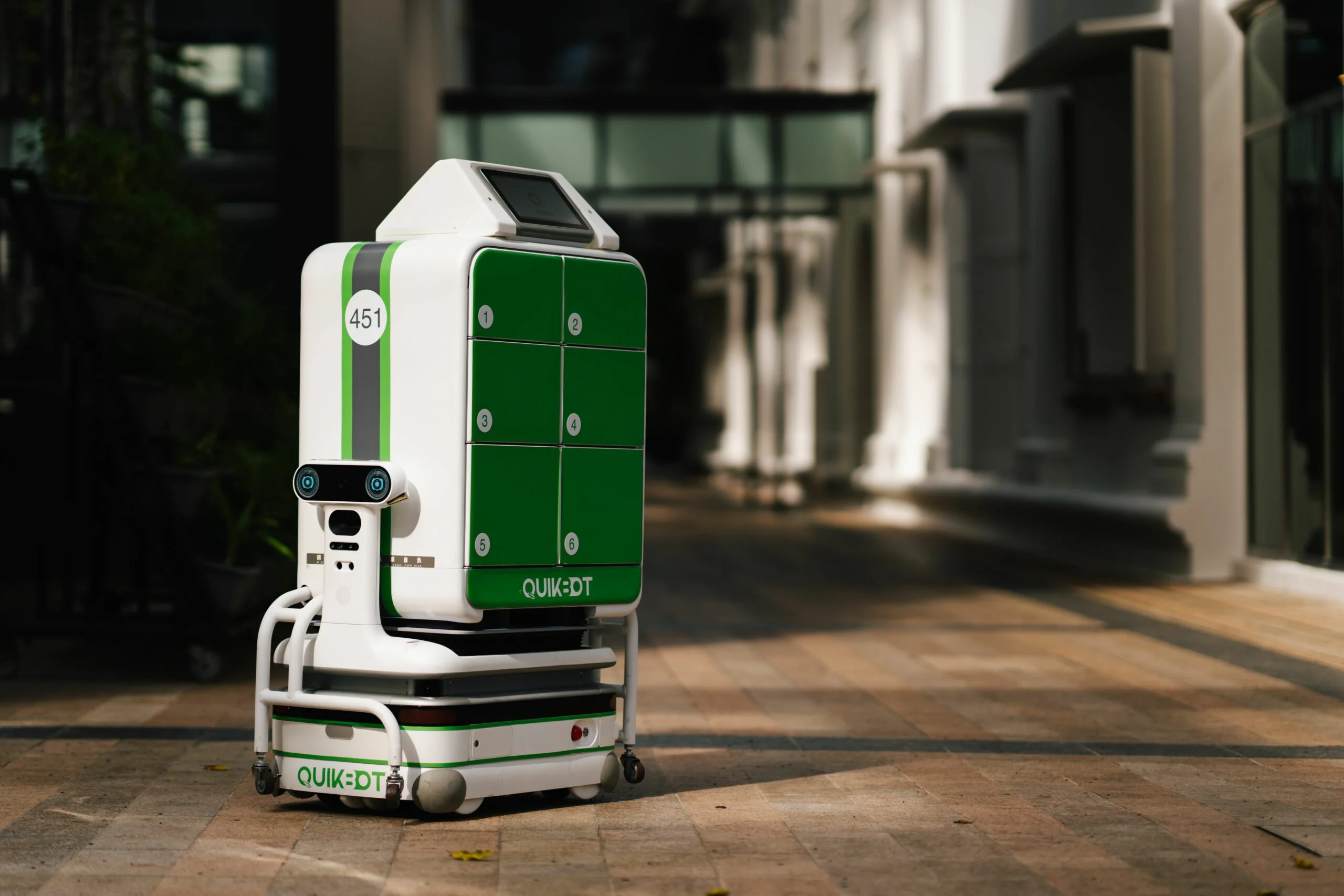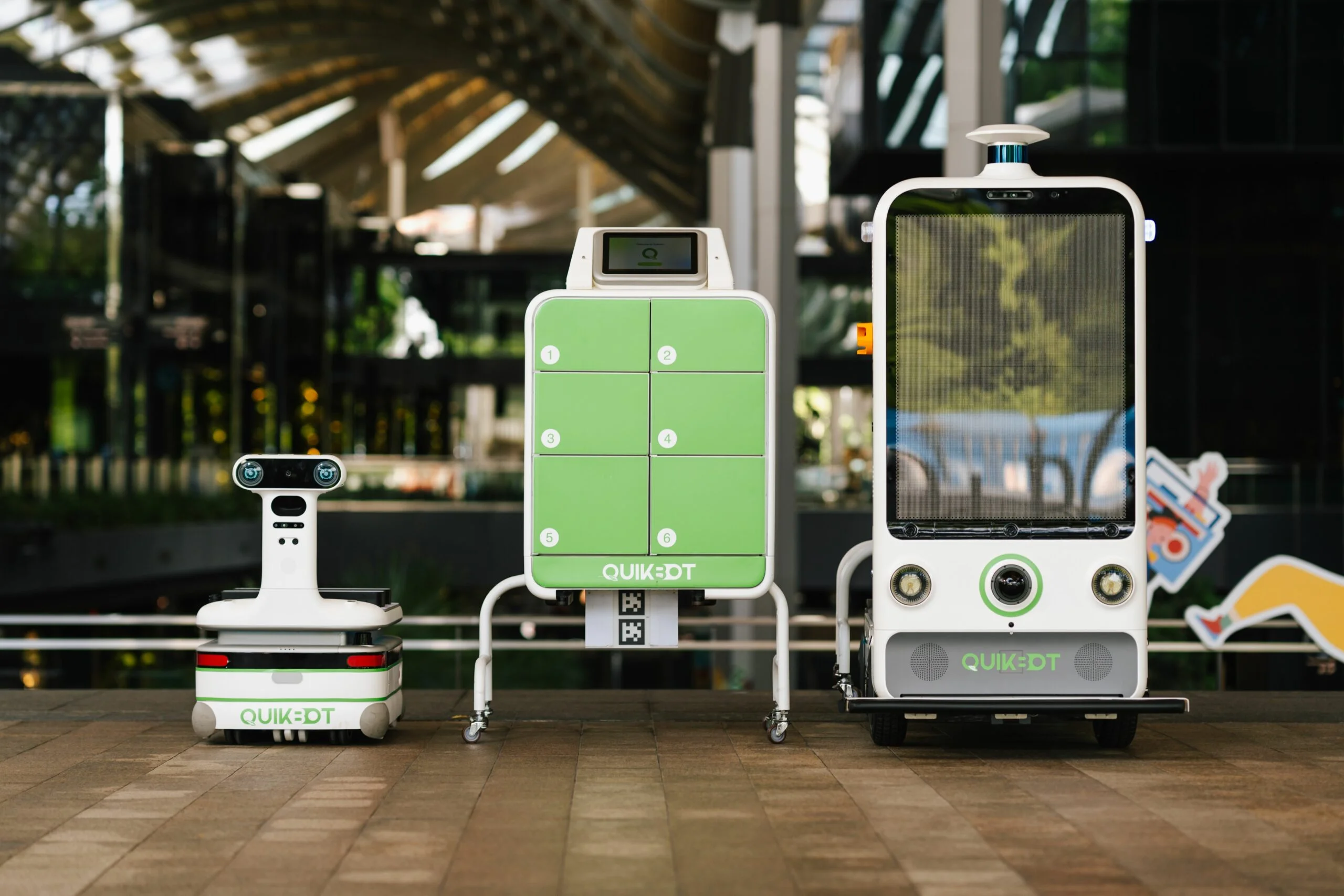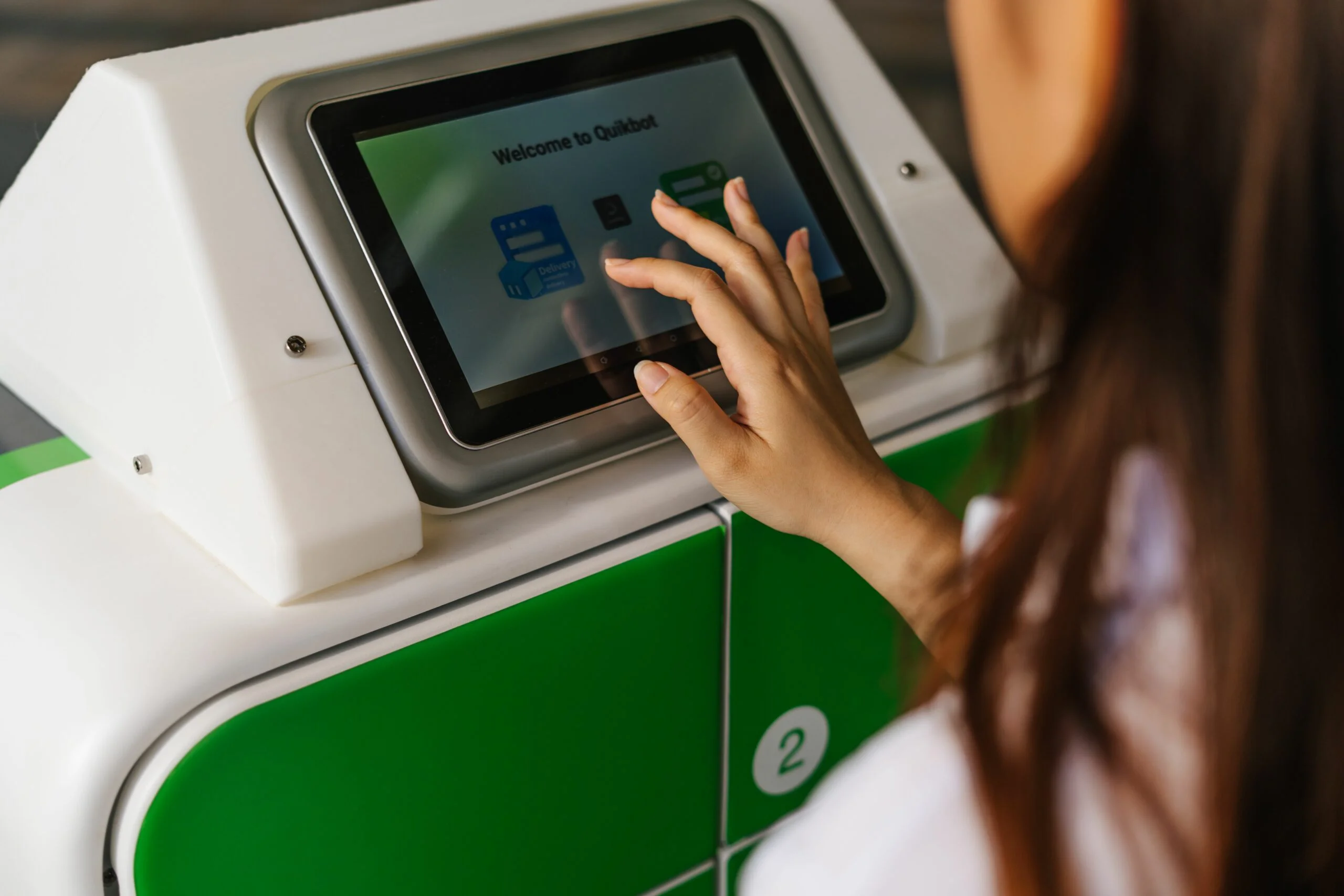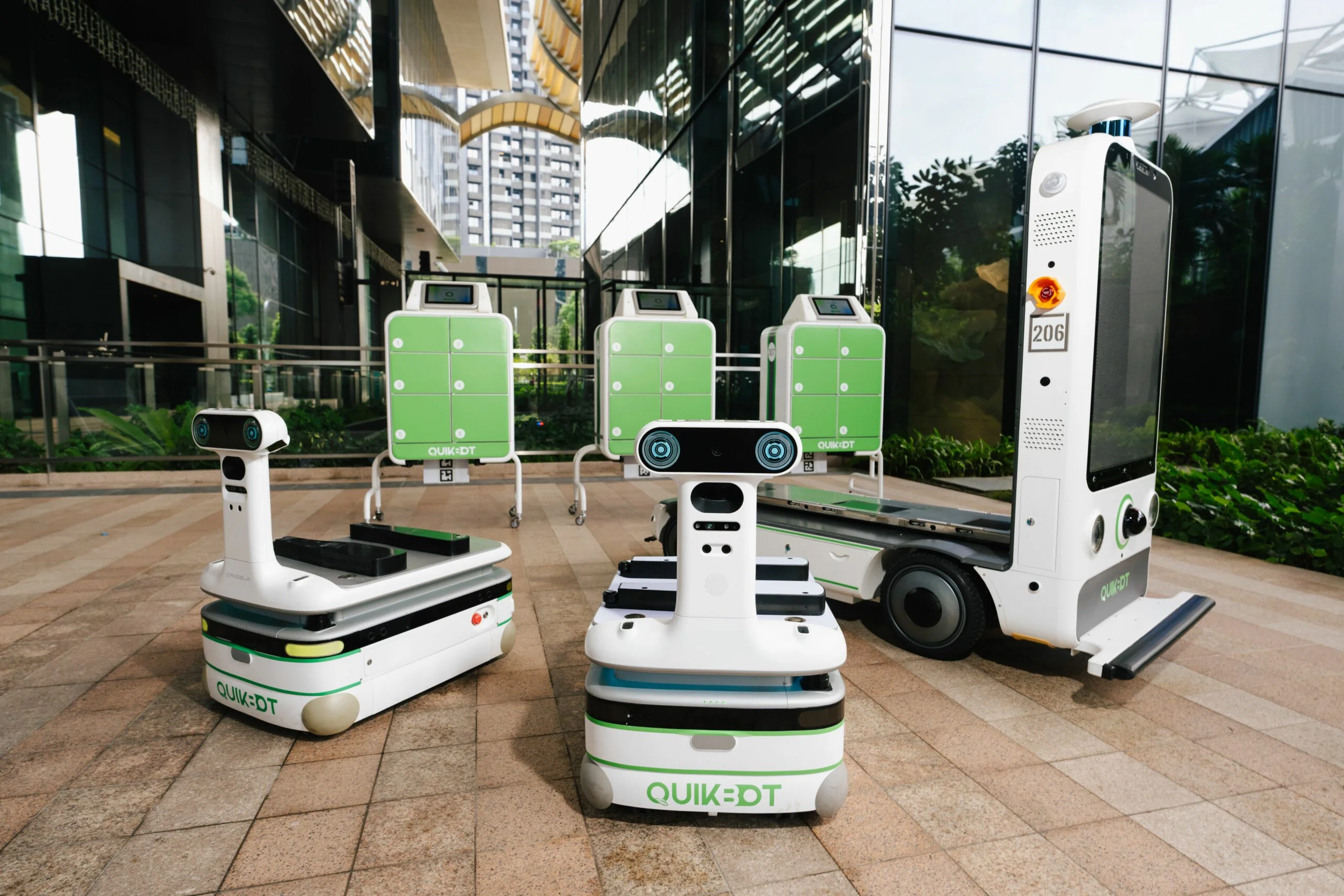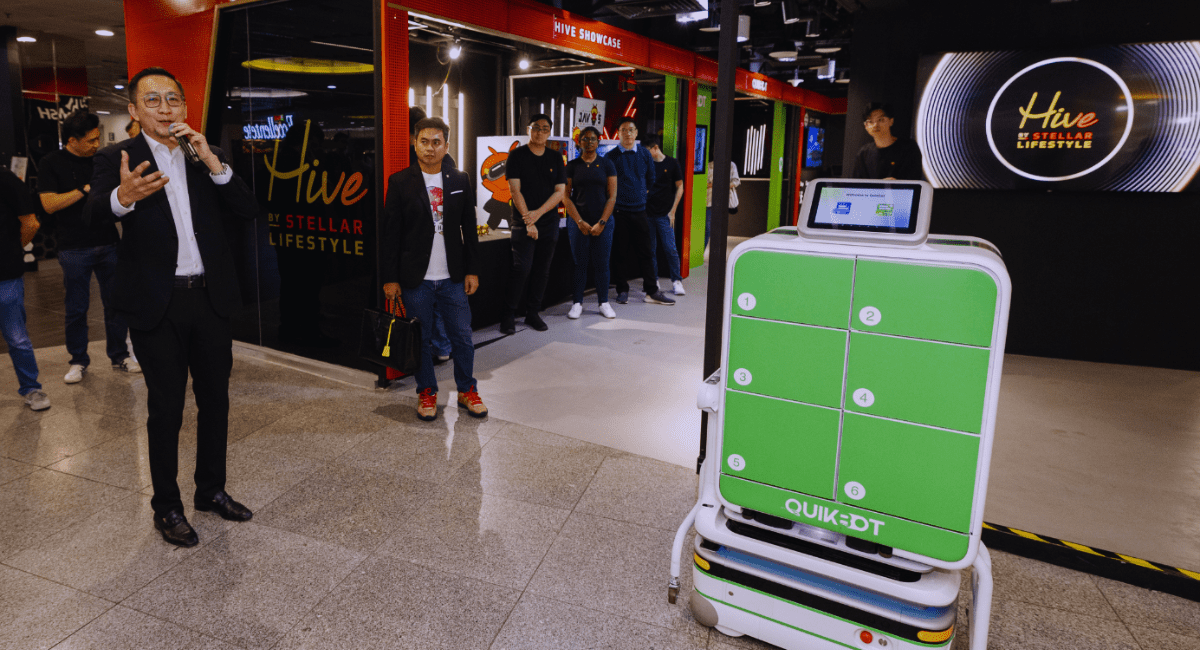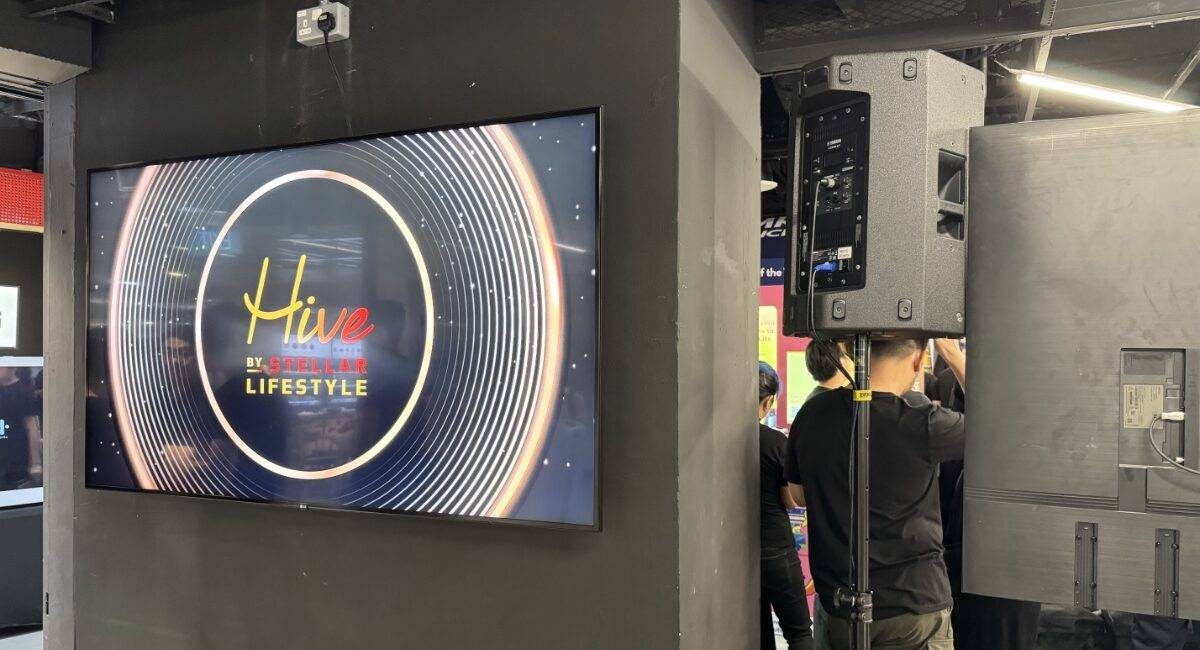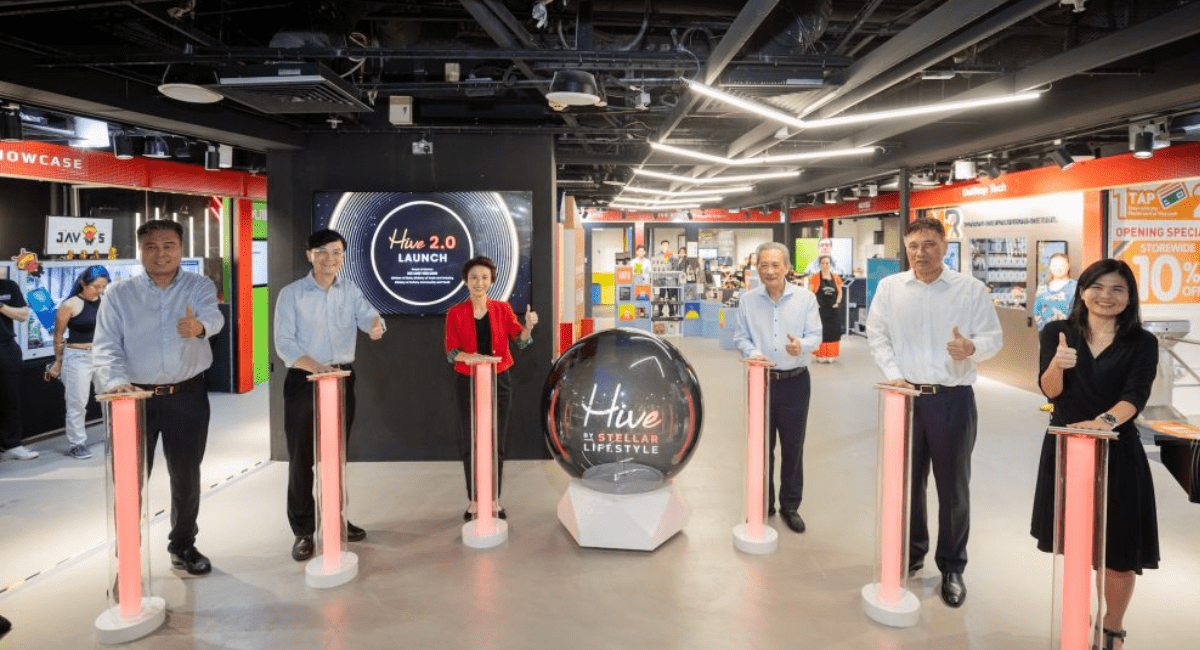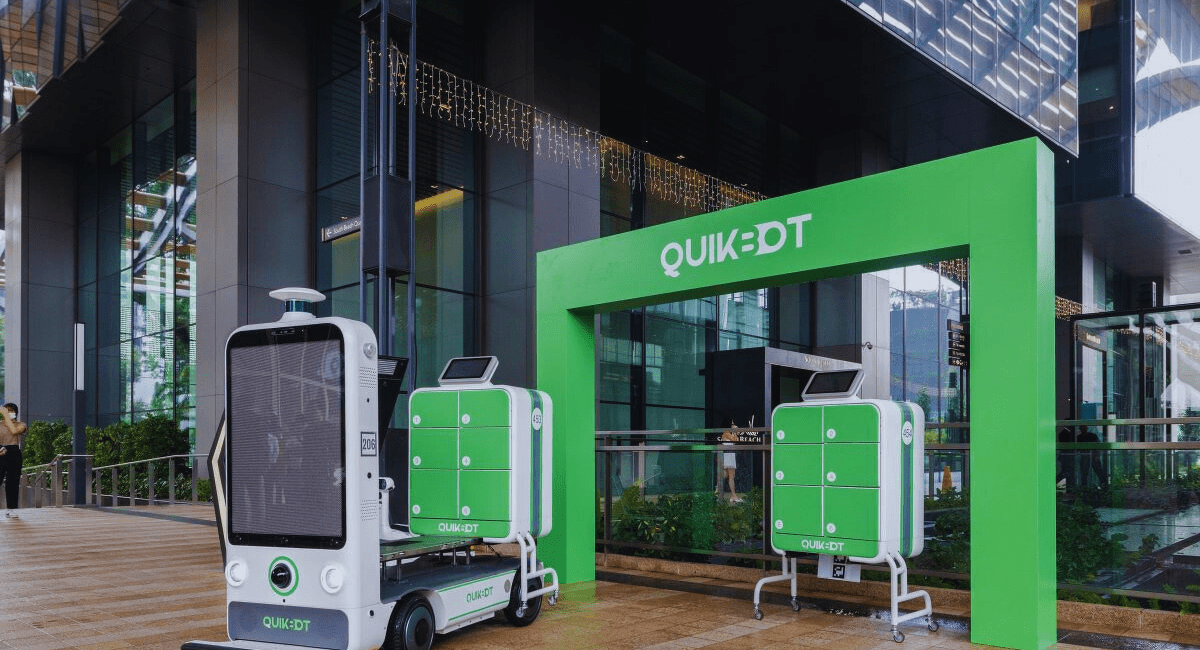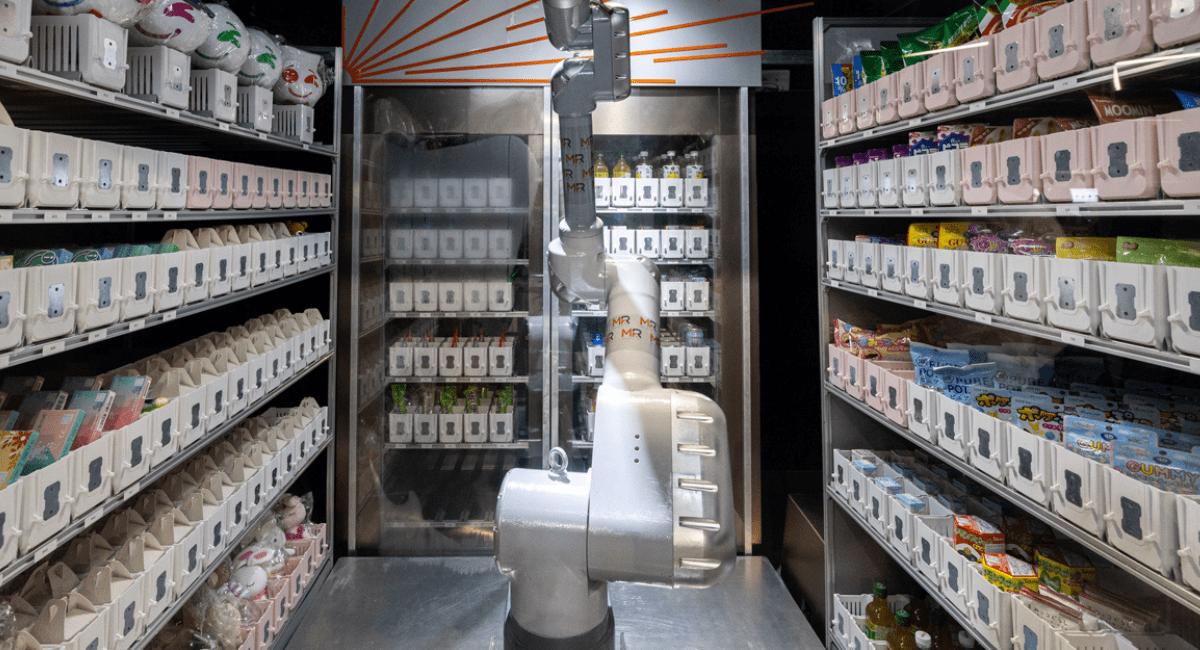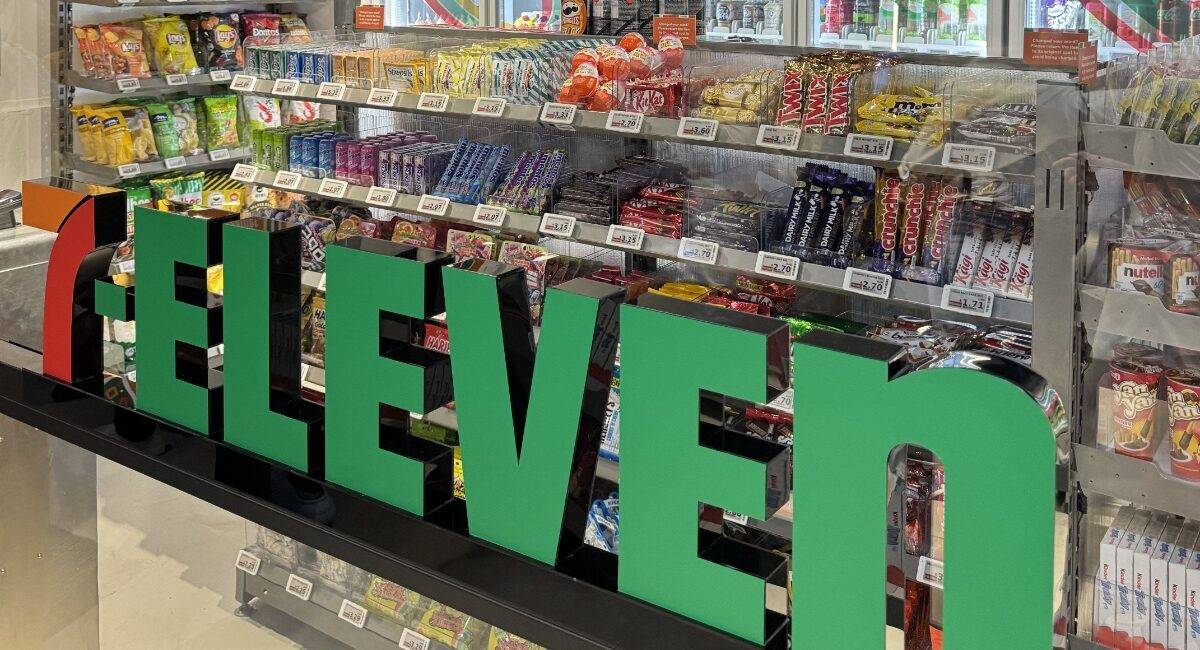A revolutionary collaborative platform for smart cities that delivers floor-to-floor, straight to customers, offering lower costs, reduced security risks, and increased sustainability.
A revolutionary collaborative platform for smart cities that delivers floor to floor, straight to customers, offering lower costs, reduced building security risks, and sustainability.

We can be deployed in:
- Office Buildings
- Residential Apartments
- Hotels
- Institutions
- School/Universities
- Logistics Depots
- Shopping Mall
- Retail Outlets
- Underground Malls
Our Autonomous Delivery Platform Could Potentially Save (in a year)
Reducing Carbon Footprint
Reduction in Manpower Costs
Faster SLAs
Meet the QuikBot Team
QUIKCAT
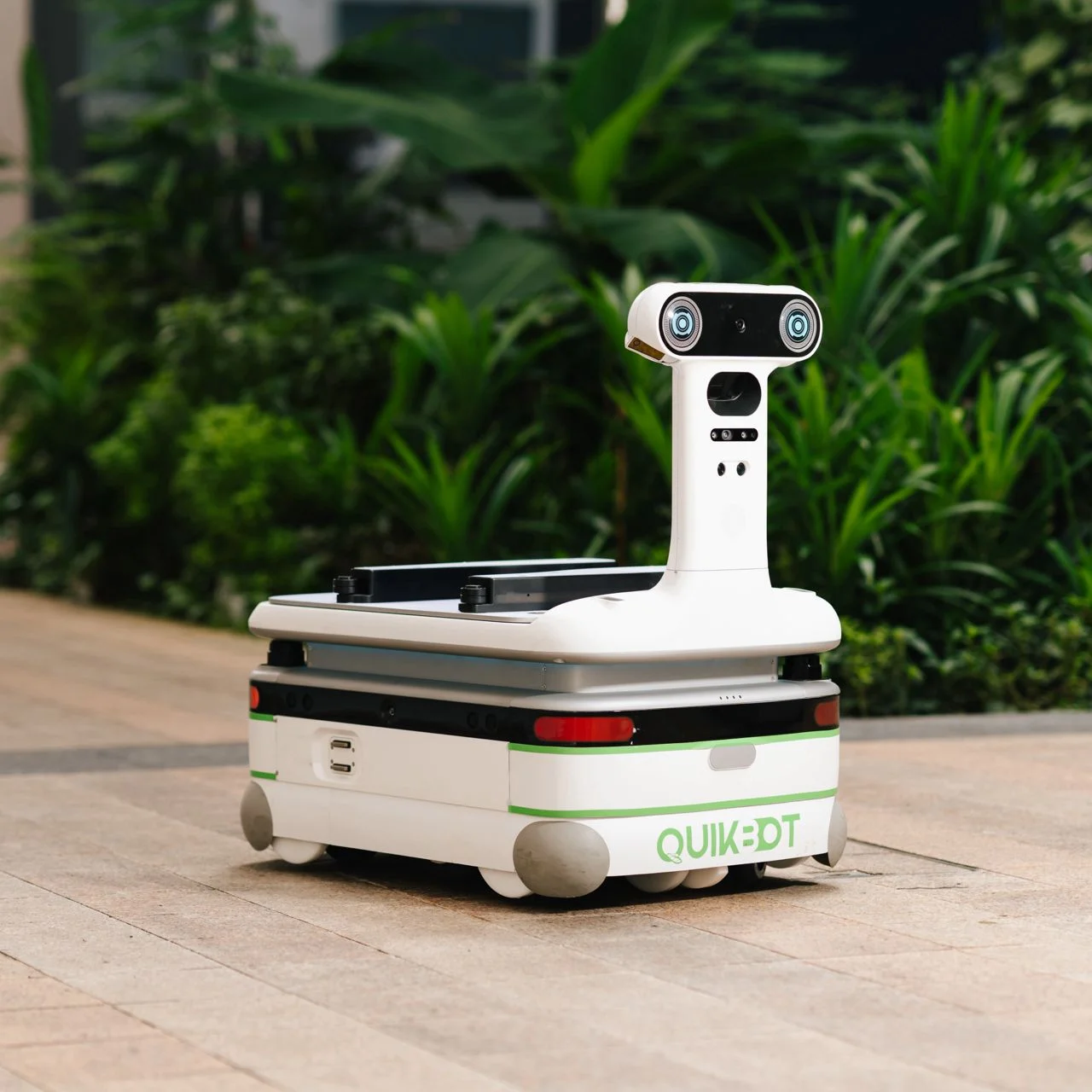
QuikCat
A short-distance autonomous robot designed to quickly deliver QuikBoxes to designated locations.
QUIKFOX
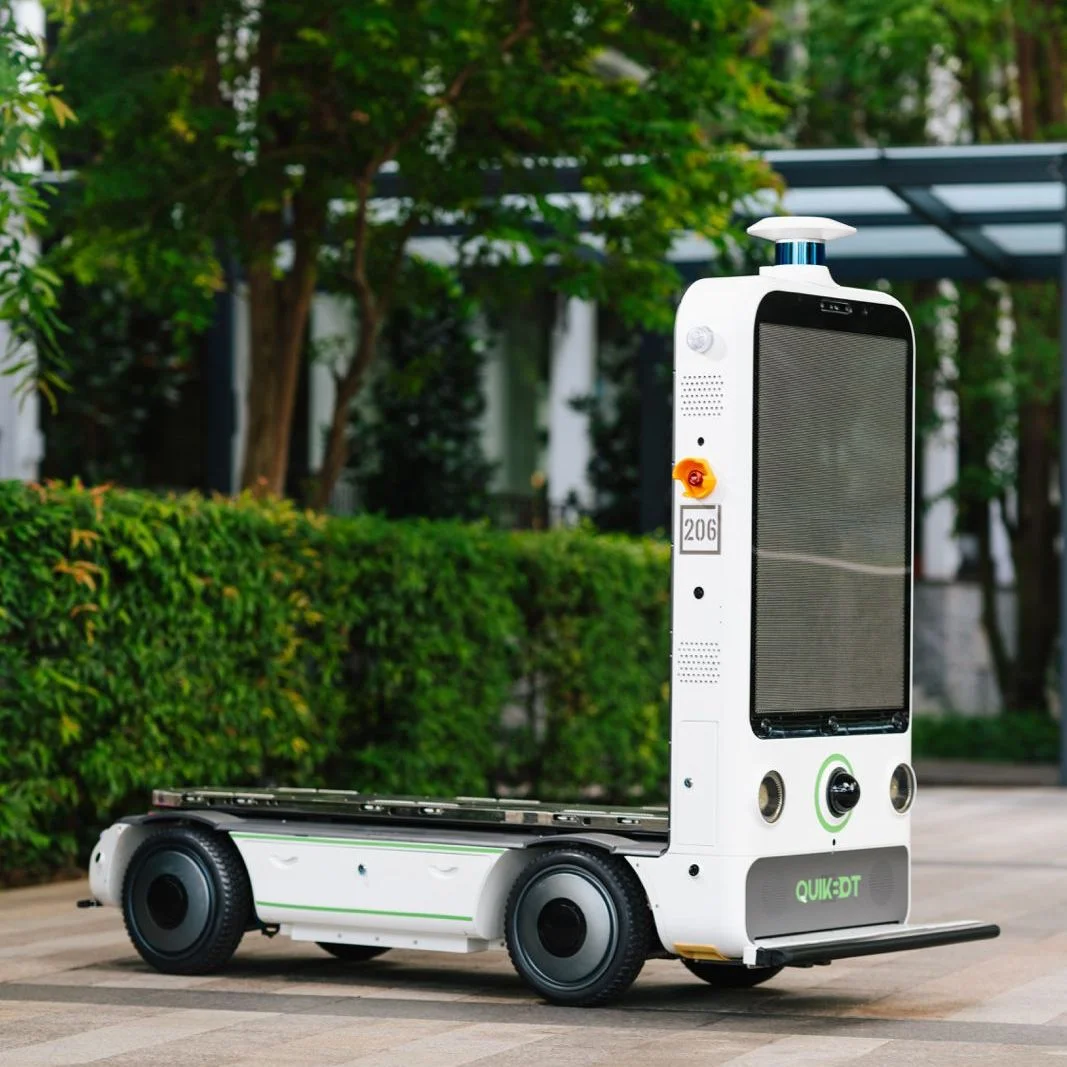
QuikFox
A long-distance autonomous robot capable of carrying three QuikBoxes and handing them off to QuikCat for last-mile delivery.
QUIKBOX
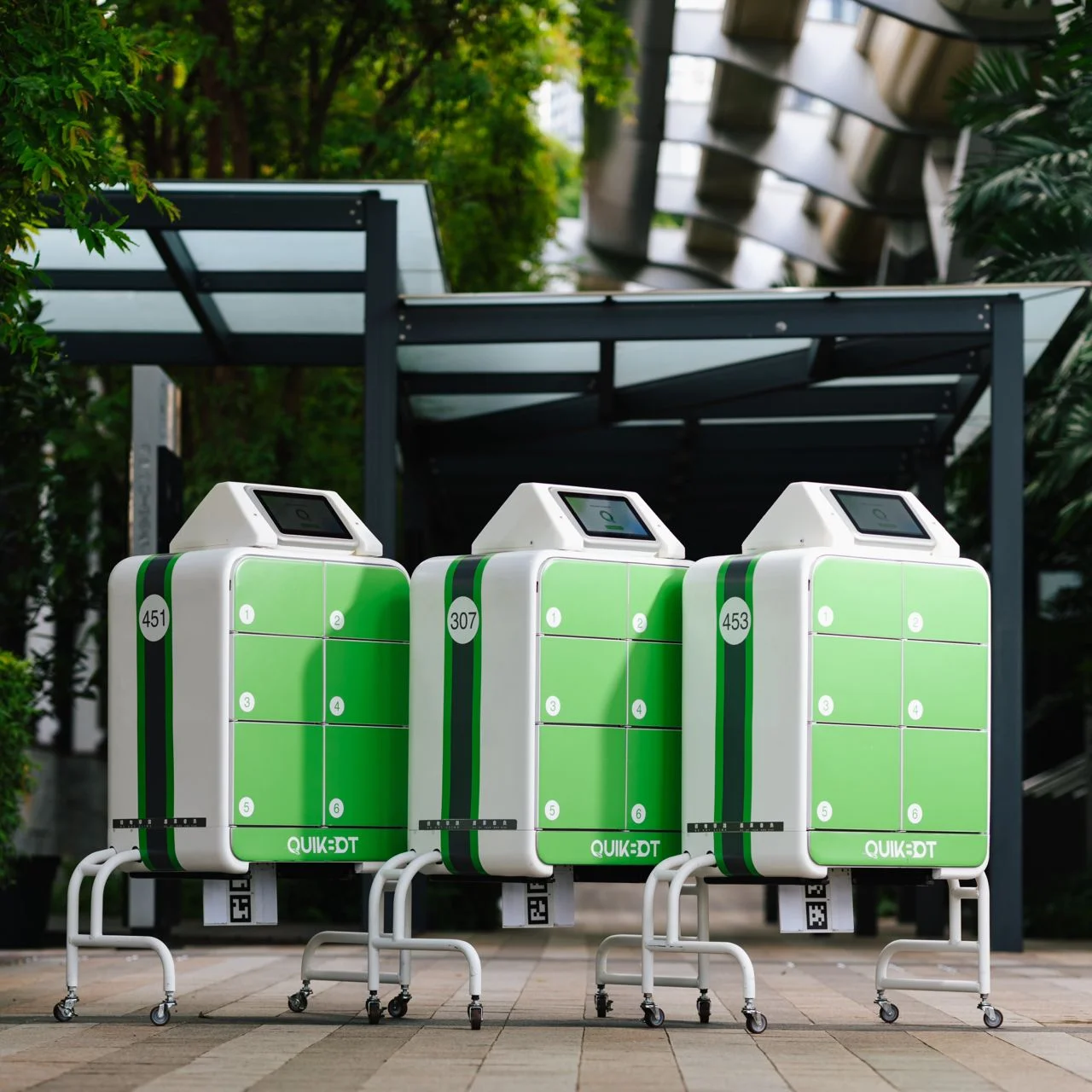
QuikBox
Smart lockers equipped with security cameras, containing six individual lockers for different items and users.
The Benefits of our Platform-as-a-Service over Traditional Delivery-as-a-Service
Reduce Cost
We can reduce delivery costs by optimising routes and efficiently mapping demand locations. This is more cost-effective than human delivery personnel, who may need multiple trips to the same location, increasing operational costs.
Reduce Delivery Time
Our AFMD robots save time by operating without breaks, following optimized routes, and avoiding traffic delays. Their ability to work continuously and efficiently handle multiple deliveries in one trip reduces delivery times significantly compared to traditional methods, ensuring faster and more reliable service for customers.
Reduce Carbon Footprint
We reduce our carbon footprint by using electric power, which cuts down on fossil fuel consumption and emissions. Using AI, we have efficiently optimised routes and consolidated deliveries, minimising energy use and further lowering environmental impact. By replacing traditional delivery vehicles, our robots contribute to cleaner air and a greener urban environment.
Reduce Manpower Issues
The shortage of skilled personnel to manage traditional delivery vehicles like vans or motorbikes can lead to longer Service Level Agreements (SLAs). With AI, a fleet of robots can efficiently handle delivery requests, reducing the reliance on human workers.
Reduce Security Risks
Managing the security of infrastructure is crucial, especially where multiple passes are exchanged, such as in building lobbies. Autonomous delivery solutions can reduce security risks with onboard security clearance and tracking, providing more controlled access.
Increase Customer Satisfaction
We enhance customer satisfaction by providing faster, more reliable deliveries. The convenience of receiving packages directly at the doorstep without scheduling conflicts or human errors, such as delivery to the wrong address, adds to a seamless and satisfying customer experience.
A Truly Sustainable Final Mile
Energy Efficiency
Autonomous robots typically consume less energy compared to traditional delivery vans. Their small size and efficient design mean that they require less energy to operate, contributing to overall energy savings.
Decreased Traffic Congestion
Delivery robots can navigate through pedestrian paths and bike lanes, making more efficient use of available space and reducing the strain on conventional roadways.
Waste Reduction
Autonomous delivery systems often require less packaging, as the robots can be designed to securely transport items without the need for excessive protective materials. This leads to a reduction in packaging waste.
Reduction in Carbon Emissions
QuikBot's delivery robots are electric-powered, which means they do not emit greenhouse gases like traditional fuel-based delivery vehicles. This reduces the carbon footprint associated with last-mile delivery. The use of AI to optimize delivery routes minimizes the distance traveled and the time spent on deliveries, further reducing emissions.
Support for Local and Sustainable Businesses
QuikBot’s focus on local deliveries supports small businesses and reduces the need for long-haul transportation, which is often more carbon-intensive. Partnering with local, sustainable businesses further enhances the overall environmental benefits of the delivery service.
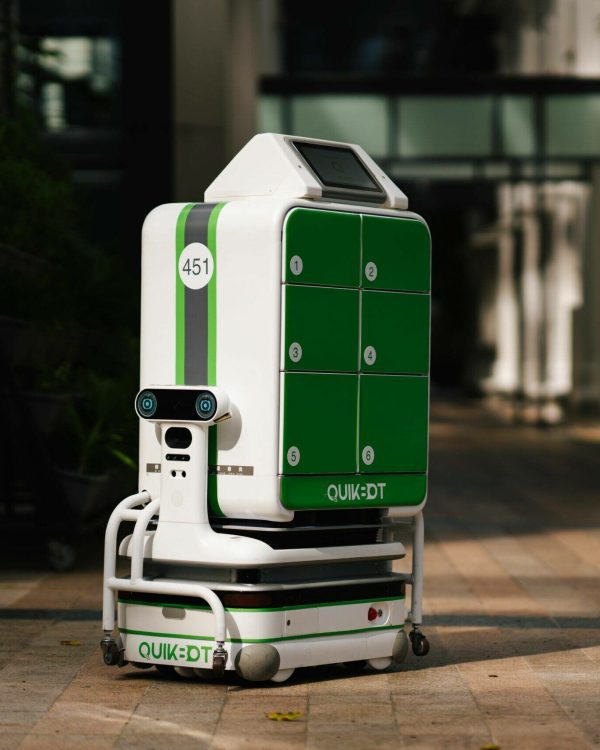
- Electric-Powered Vehicles: QuikBot’s delivery robots are electric-powered, which means they do not emit greenhouse gases like traditional fuel-based delivery vehicles. This reduces the carbon footprint associated with last-mile delivery.
- Optimized Delivery Routes: The use of AI to optimize delivery routes minimizes the distance traveled and the time spent on deliveries, further reducing emissions.
- Low Energy Consumption: Autonomous robots typically consume less energy compared to traditional delivery vans. Their small size and efficient design mean that they require less energy to operate, contributing to overall energy savings.
- Reduction of Delivery Vehicles on Roads: By using robots for last-mile delivery, QuikBot reduces the number of delivery trucks and vans on the roads. This helps to alleviate traffic congestion, particularly in urban areas.
- Efficient Use of Space: Delivery robots can navigate through pedestrian paths and bike lanes, making more efficient use of available space and reducing the strain on conventional roadways.
- Local Deliveries: QuikBot’s focus on local deliveries supports small businesses and reduces the need for long-haul transportation, which is often more carbon-intensive.
- Eco-Friendly Partnerships: Partnering with local, sustainable businesses further enhances the overall environmental benefits of the delivery service.
- Packaging Innovations: Autonomous delivery systems often require less packaging, as the robots can be designed to securely transport items without the need for excessive protective materials. This leads to a reduction in packaging waste.
Top 3 Challenges with Last Mile Delivery
Mckinsey & Co study found that Last Mile Delivery accounts for more than 53% of total shipping costs.
More than 61% of logistics companies agree that last mile delivery is the most inefficient process in the the entire supply chain.
People resources are a constant challenges in the last-mile delivery service quality and predictability
What Our Solution Delivers
Overall Cost Saving
Increase in Efficiency
Increase in Service Quality


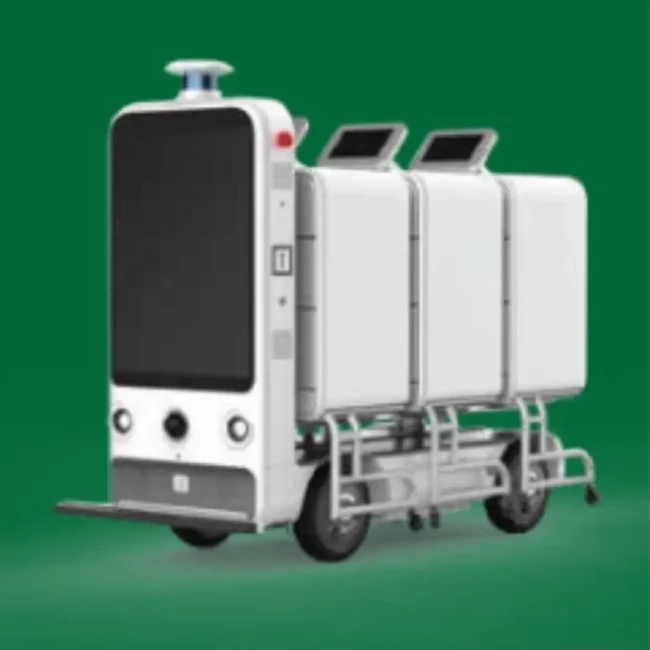

Singapore Projects
We have deployed in South Beach Singapore and have signed MOU to deploy in Suntec City, One North, Mapletre Business City, Punggol Digital District and more.
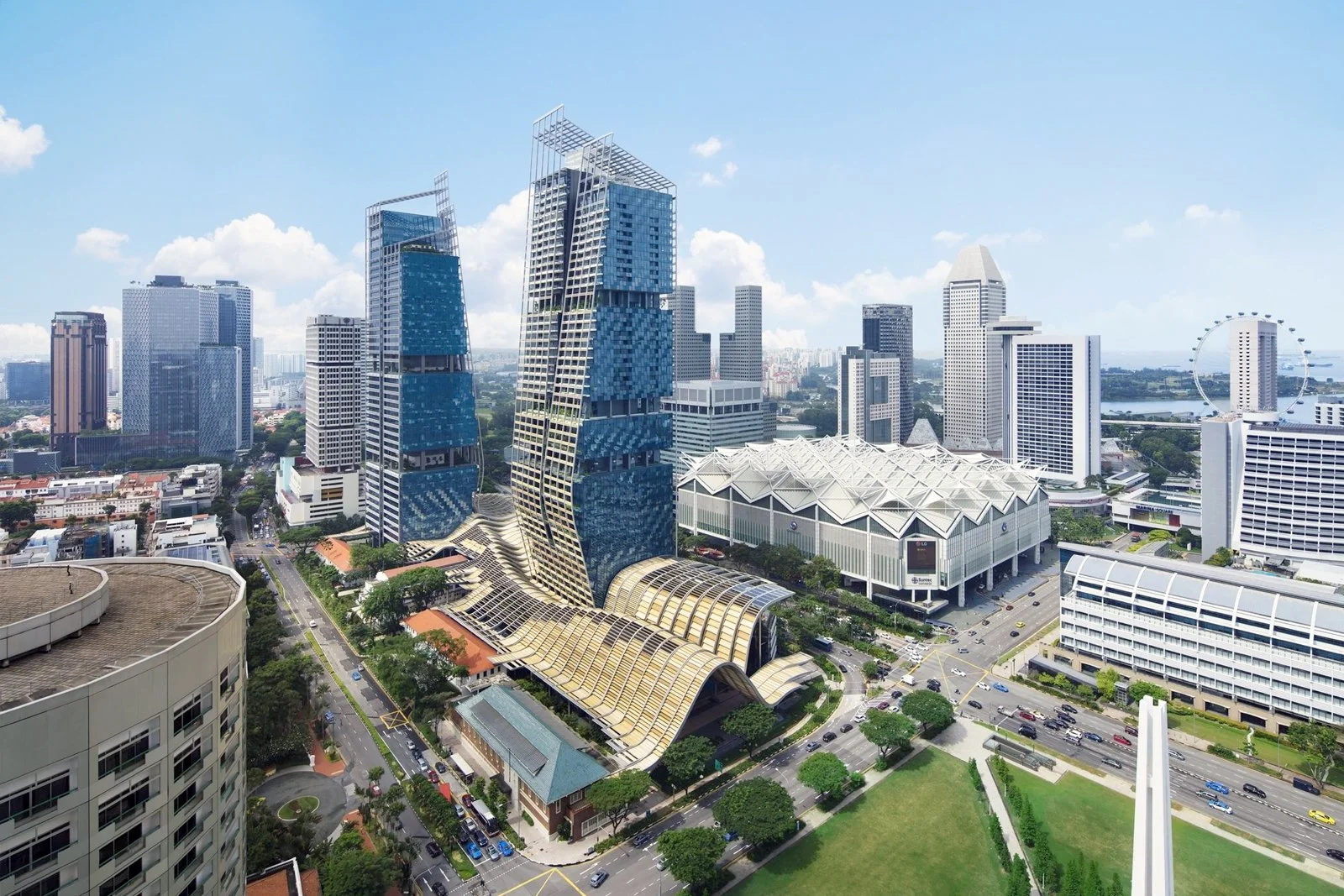
South Beach
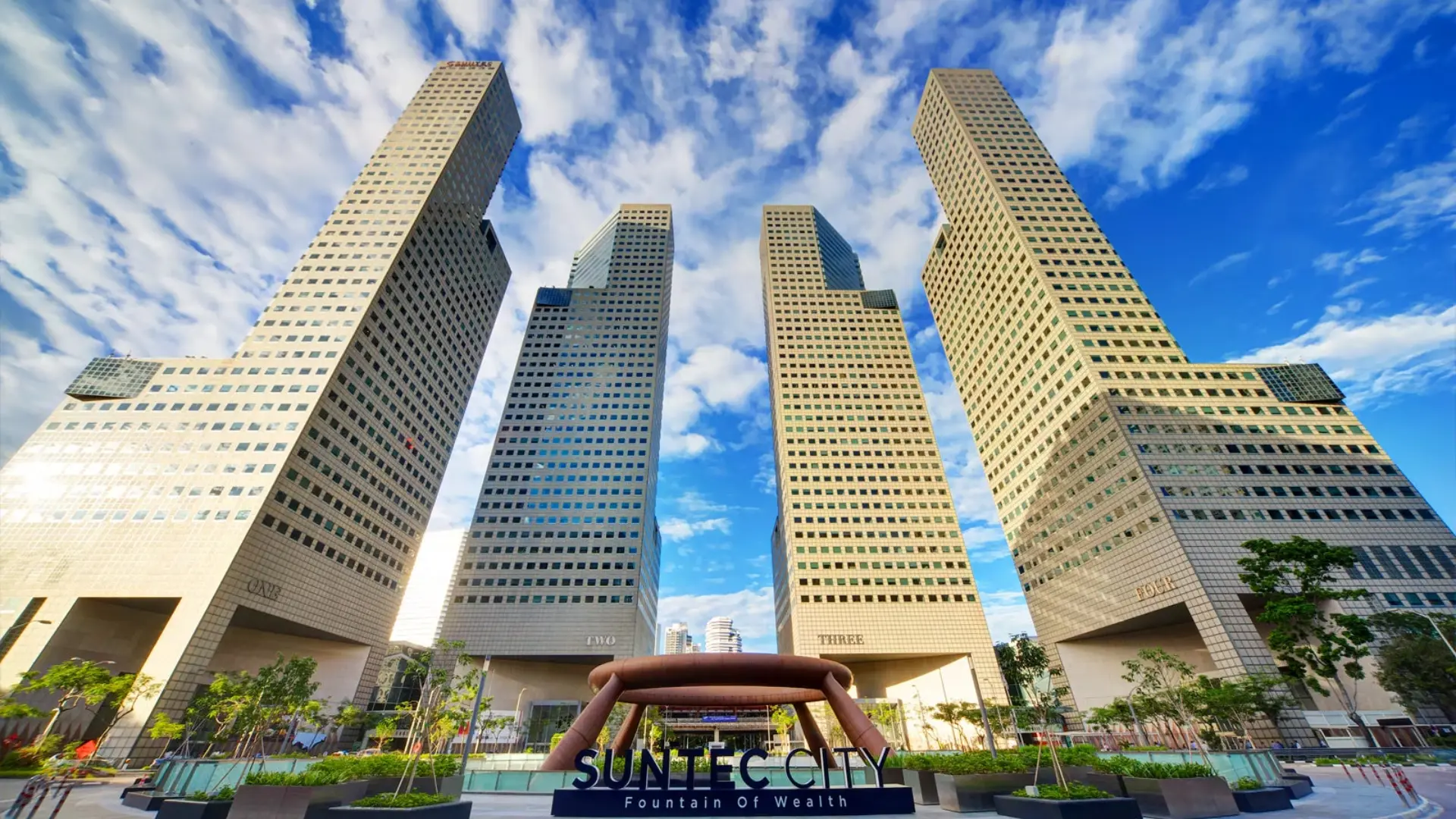
Suntec City
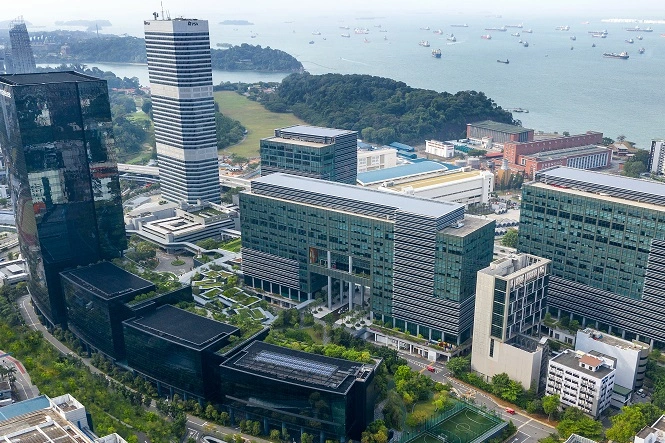
Mapletree Business City
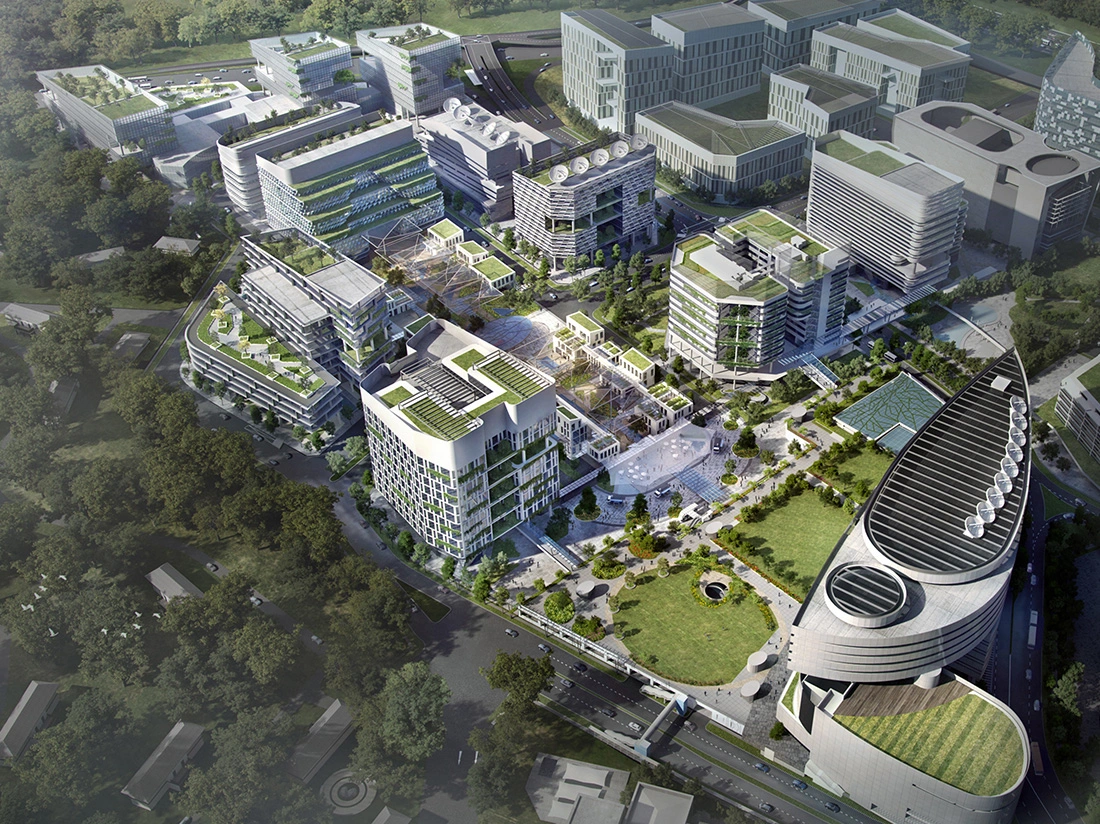
One North
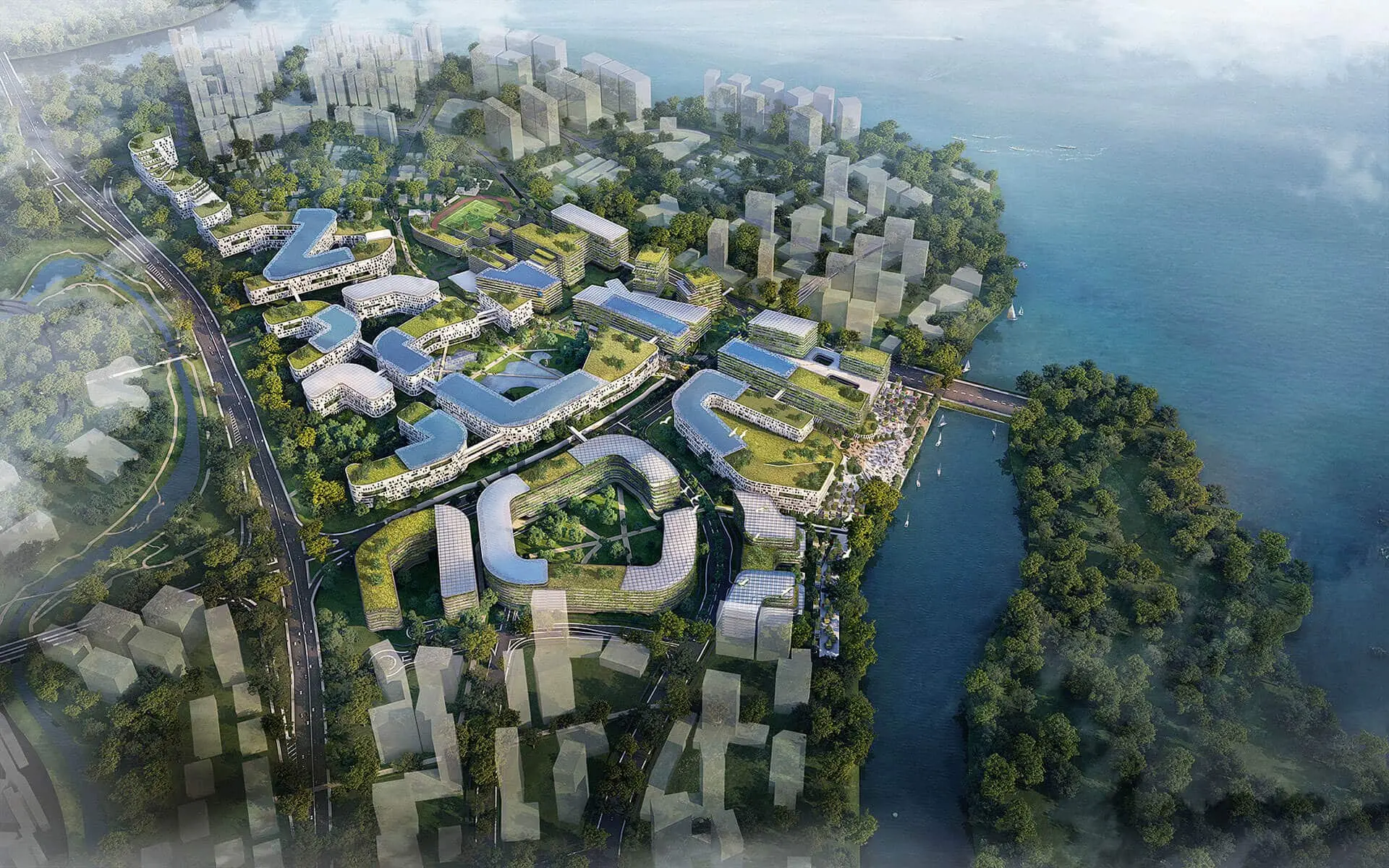
Punggol Digital District
Our Roadmap
QuikBot has set its eyes to Tokyo, Osaka, Seoul, Incheon, Dubai, Abu Dahbi, Sydney, Melbourne, Hong Kong and more… QuikBot plans to deploy at 400 buildings or at 70 services clusters within the next 5 years.
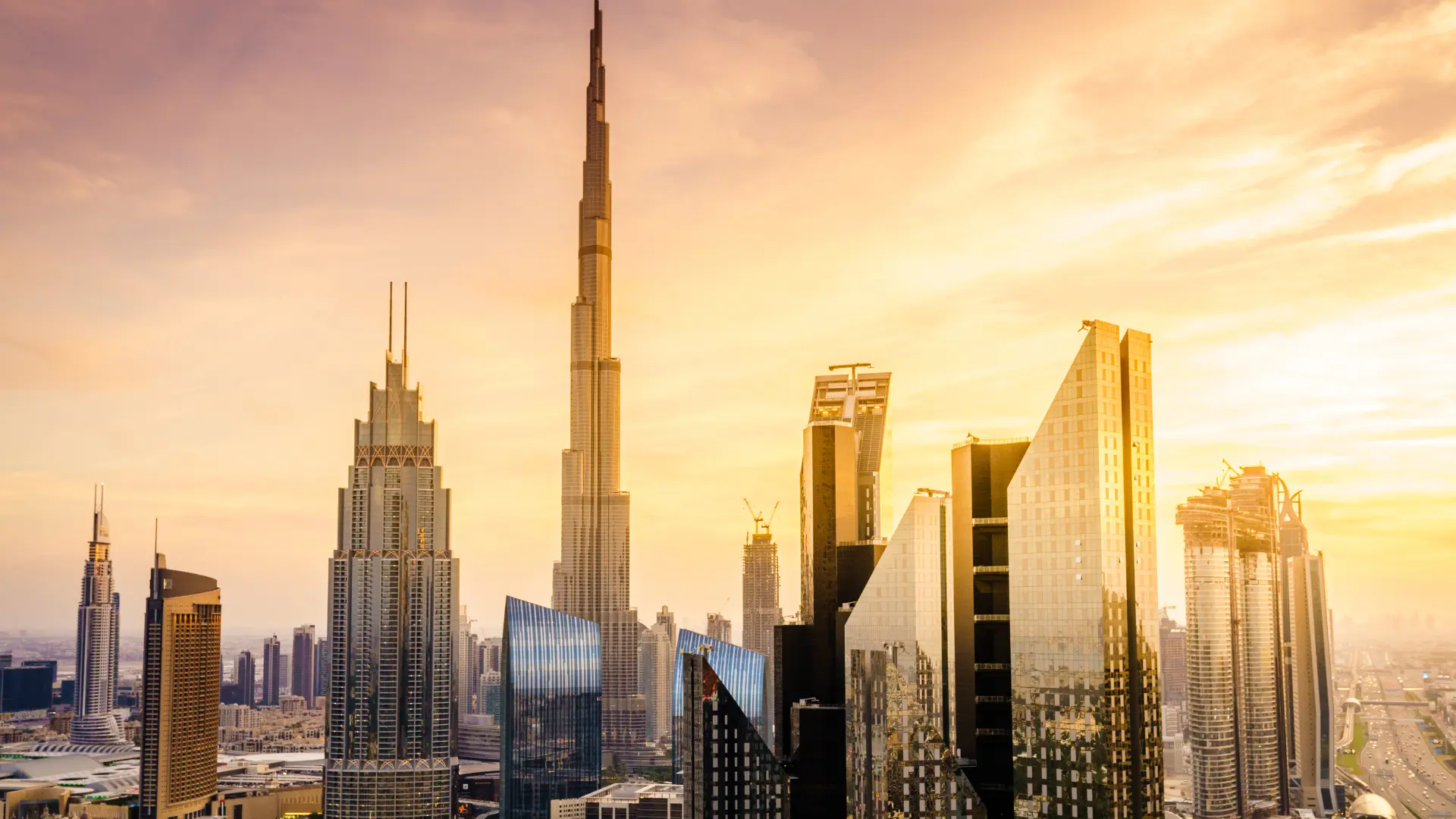
Dubai
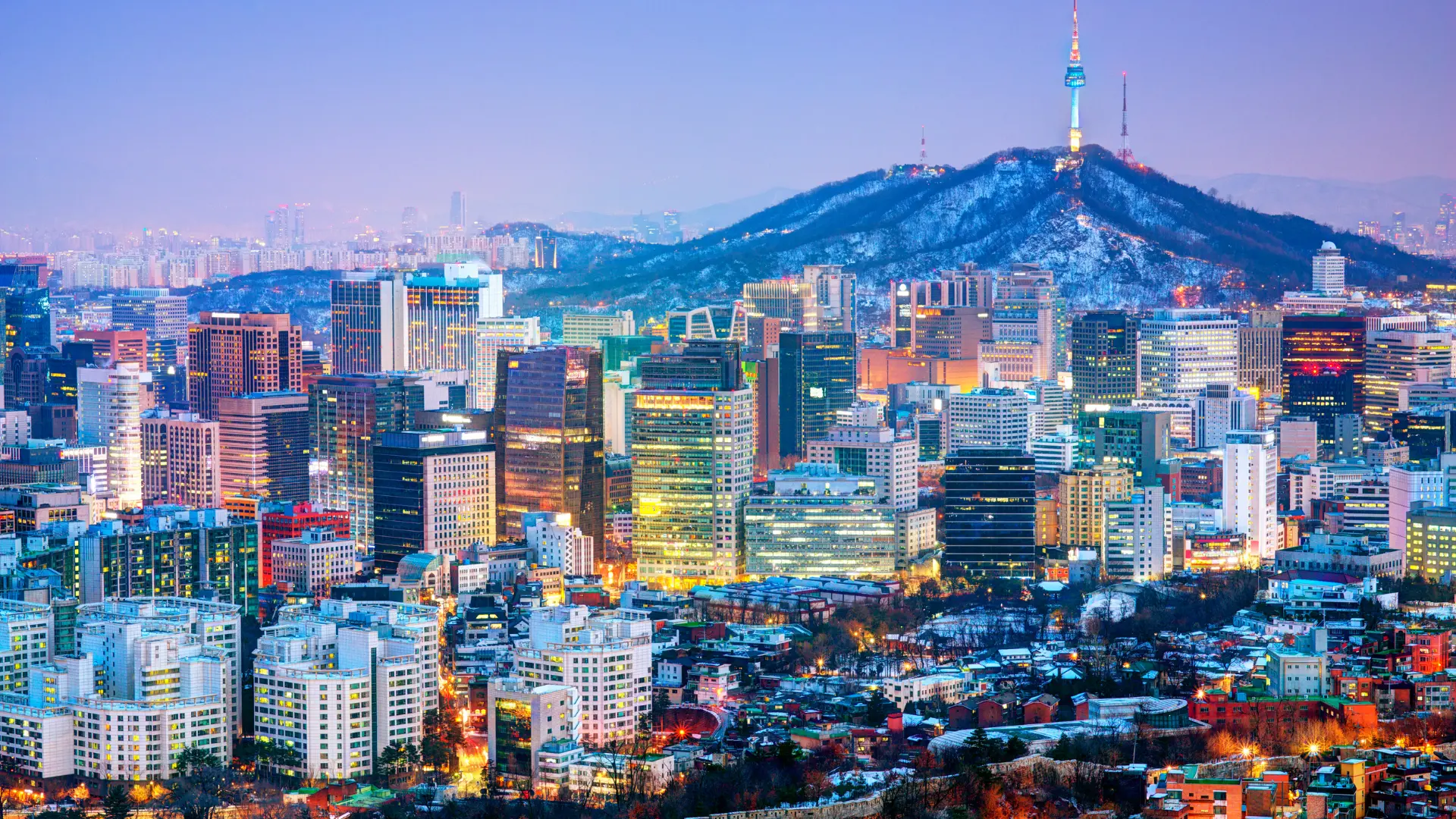
Seoul
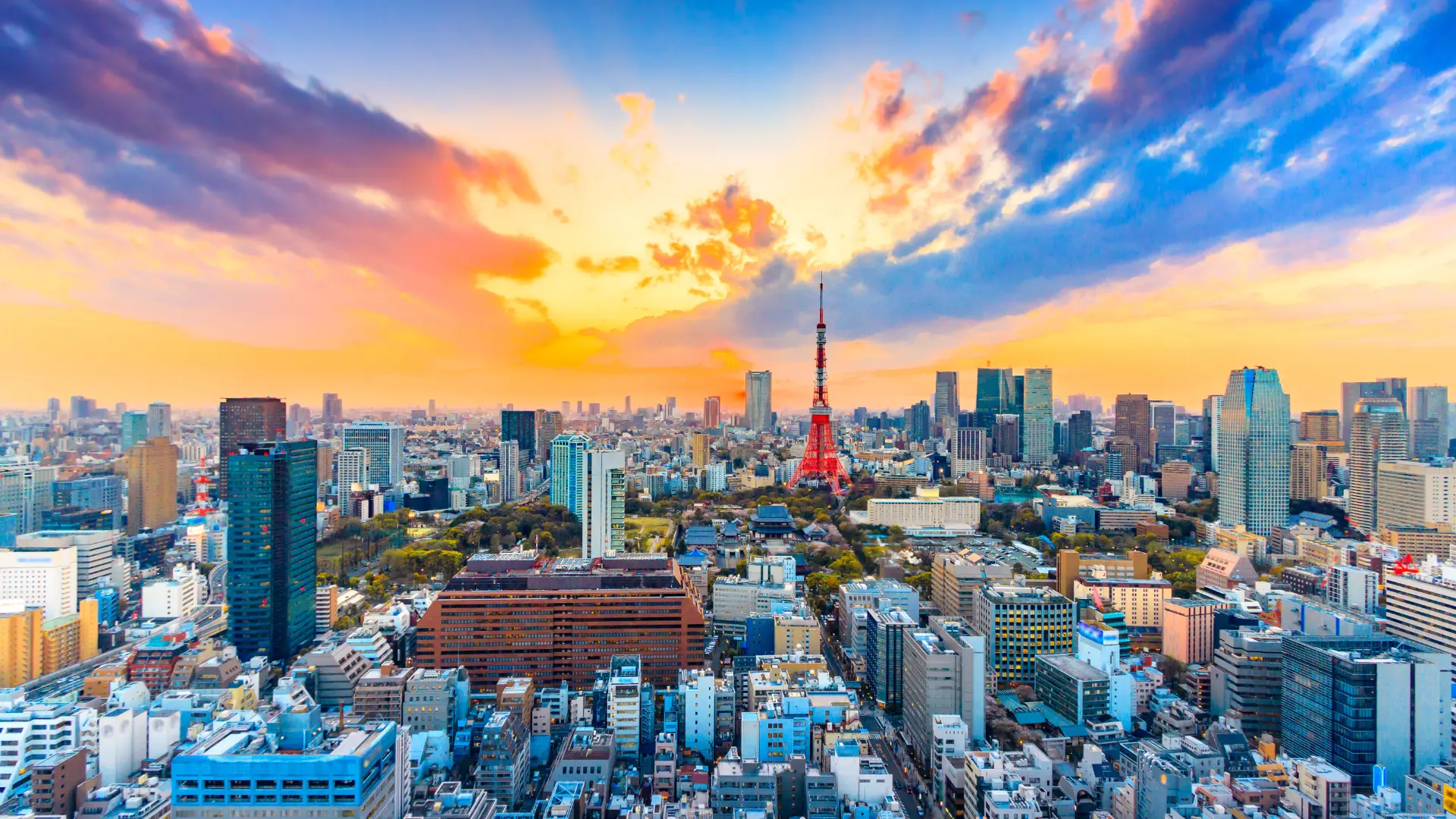
Tokyo
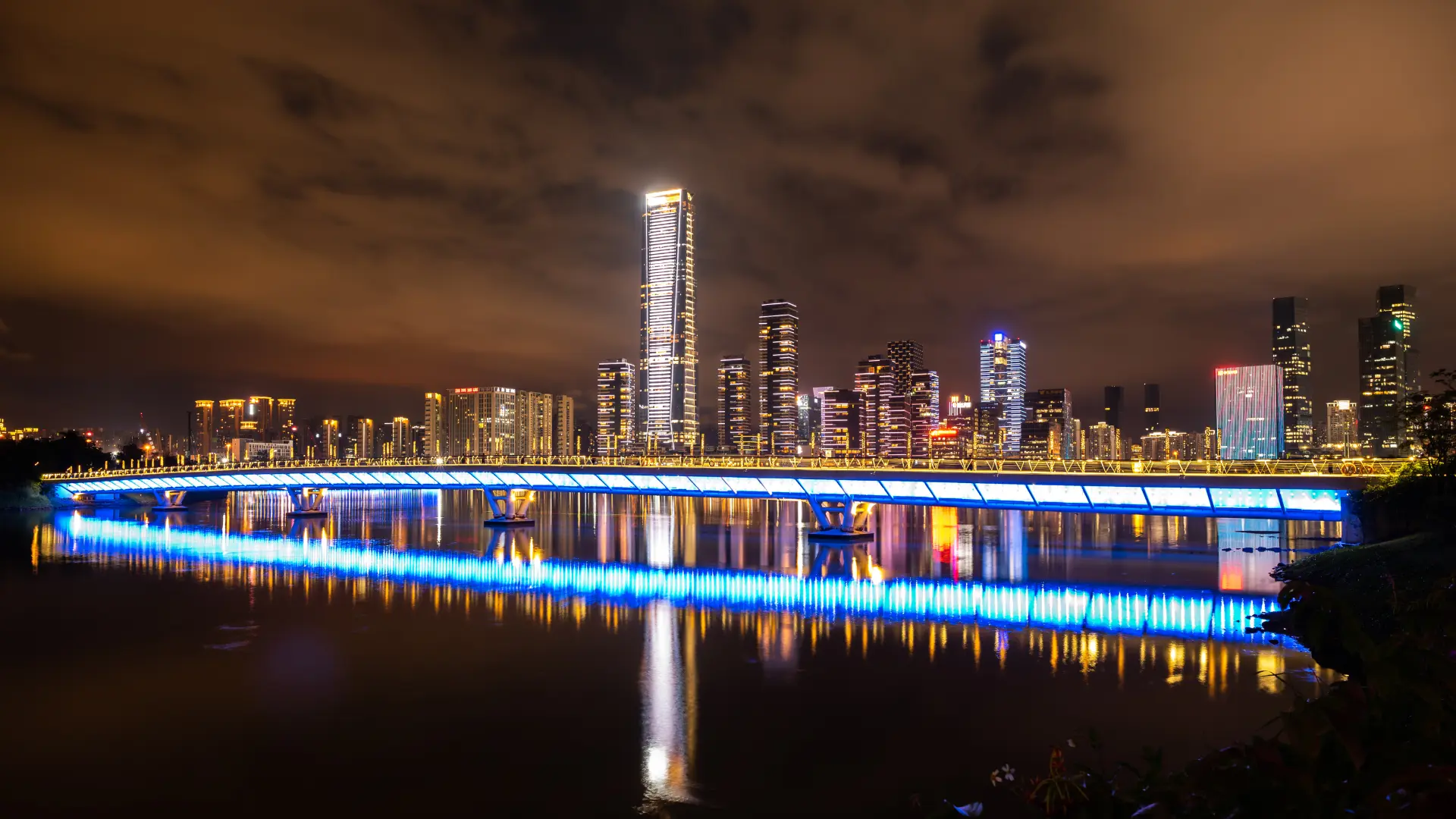
Hong Kong
Latest News
We have now started our POC in South Beach Property and Commercial trial-to-service with Suntec City, Mapletree Business City, Republic Plaza & Ocean Financial Centre.
Our Partners
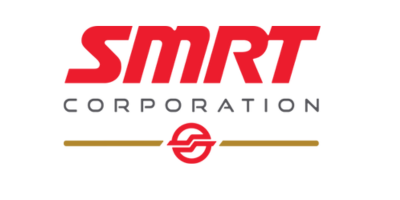
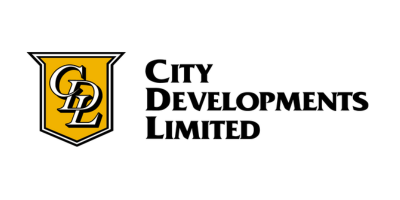


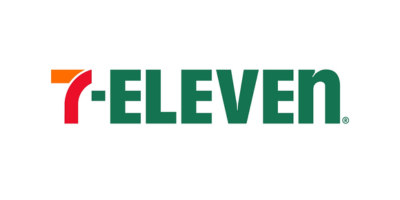


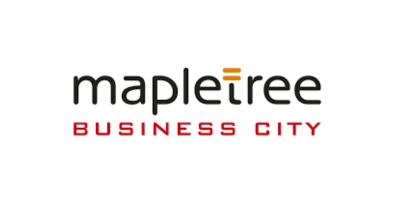

Featured On












Singapore (Headquarters)
©2024 Quikbot Technologies Pte Ltd
Thank you for your interest in QuikBot Technologies. Our team will review your submission and get back to you shortly with potential next steps.
(Head of Operations)
Mr. Kieran Foo holds a Bachelor of Business Management and a Master Degree in Sport Management. Although trained in business, Kieran possesses working experience in engineering and joined QuikBot as a Test Engineer before being promoted to Operation Manager. He is responsible for the deployment and integration of our technology into the lifts, turnstiles, and access points at building infrastructures. These properties include Esplanade MRT, South Beach Tower, Suntec City, and One Fusionopolis. Mr. Foo is thus highly experienced in the administrative, operational, and technical aspects of equipping legacy lifts with technology for robot-assisted last-mile delivery. He liaises with property owners and facility managers as well as equipment operators like KONE, Mitsubishi, Toshiba, and Fujitec.
(VP, Strategic Partnership)
Kenneth is a seasoned executive with over 30 years of management experience across various industries, including banking and finance, biotech healthcare, manufacturing, business consulting, and real estate development. He holds a double degree from the National University of Singapore (NUS) and an Executive MBA from CEIBS, Shanghai. At QuikBot Technologies, Kenneth is responsible for building a strategic partners network and driving business development to support the company’s Autonomous Final-mile Delivery Platform-as-a-Service (AFMD PaaS). His extensive connections to senior leadership in the Singapore corporate world, combined with his resourcefulness in forging strategic partnerships, are pivotal to integrating QuikBot’s innovative robotic parcel delivery solutions within commercial CBD properties. Kenneth’s career highlights include his role as APAC Resource Director at Ingersoll Rand Shanghai, managing talent across 12 countries, and his tenure at Algorithmic Inc., where he achieved significant sales milestones in financial risk management.
He has also spearheaded strategic partnerships at QuikBot Technologies, supported growth initiatives at FEGO Biotech, and raised US$18 million for property developments in China at Jiangshan Investment. His banking and finance experience includes senior roles at United Overseas Bank Group and Bank of America, where he achieved notable retail sales targets.
Kenneth’s resourcefulness and strong connections with senior leadership in the Singapore corporate world are critical to his effectiveness in building strategic partnerships and driving business development. His leadership, strategic vision, and extensive network are instrumental in advancing QuikBot Technologies’ innovative solutions in the robotics and automation industry.
(Head of Product Development)
Daniel is a seasoned branding and marketing strategist with nearly 20 years of experience in developing and executing successful multi-channel campaigns. Renowned for his creativity, innovation, and award-winning results, Daniel excels in brand strategy, digital marketing, and team leadership. As the Head of Product Development at QuikBot Technologies, he leverages his extensive background to drive product innovation and market growth. Throughout his career, Daniel has held significant roles across various companies. At PIF Capital, he redeveloped the brand position and strategy for the entire company, overseeing a comprehensive revamp of marketing collaterals, digital initiatives, and branding directions.
He also revamped the corporate website and launched a new ERP system to enhance operational efficiency. As VP of Branding and Marketing Communications at Maybank Singapore, he spearheaded award-winning campaigns, formulated digital roadmaps, and marketed new products, including Maybank’s FC Barcelona partnership. His tenure at other companies, such as Sedgwick Singapore, Point O One, VML (now VMLY&R), Mandate Communications, Starmedia International, and HardwareZone.com®, showcases his versatility and expertise in various facets of marketing and branding.
Daniel’s impressive achievements have earned him numerous accolades, including multiple awards for best advertising campaigns, branch innovation, and production and cinematography. His work has been recognised at prestigious events such as the Retail Banker International Awards, the Asian Banking and Finance Awards, the London International Awards, and the Gong Awards.
(Co-Founder)
Hui Jie is a dynamic entrepreneur with a strong background in technology and business. At 26, he became one of the youngest Executive Directors of a London-listed company and has since served on the boards of three listed companies. He successfully founded and listed a company on the Australia Stock Exchange in 2015, achieving a market valuation of over USD 230 million. As Co-Founder of QuikBot Technologies, Hui Jie focuses on leveraging technology to address inefficiencies in final mile logistics, tackling talent, environmental, social, and governance (ESG) issues.
He holds an Executive MBA from the EMBA Global-Asia Programme, conducted by Columbia Business School, London Business School, and the University of Hong Kong, and a Bachelor of Business and Commerce from Monash University, Australia. Hui Jie has founded over 10 business ventures across Asia-Pacific, managing teams of over 200 people and successfully exiting several ventures through trade sales and listings.
His experience spans over a decade in 11 different countries, including China and Hong Kong. His qualifications include certifications from the Massachusetts Institute of Technology (MIT) in areas such as Chief Technology Officer, Full Stack MERN, and Applied Business Analytics, as well as credentials from the University of Oxford in Algorithmic Trading and Blockchain Strategy. His diverse background in technology and business development drives QuikBot Technologies’ innovative solutions in autonomous delivery and logistics.
(Co-Founder & Chief Engineer)
Dr. Wong Choon Yue is a distinguished robotics expert with approximately 18 years of R&D experience in the field. He holds a doctoral degree with a focus on human-robot teaming dynamics, specifically exploring performance outcomes when humans supervise groups of mobile robots. His post-doctoral research further advanced robotics technology, particularly in the development of humanoid robots and robotic grippers. One of Dr. Wong’s most notable achievements is the development of Edgar, Singapore’s first humanoid robot, which he accomplished as early as 2015-16. This groundbreaking work established him as a leading figure in robotics innovation in Singapore.
In addition to his practical achievements, Dr. Wong is a respected academic. He lectures at Nanyang Technological University (NTU), where he is a fellow specialising in Autonomous Mobile Robot (AMR) technologies. His academic contributions and dedication to advancing robotics education are highly regarded in the academic community. As the Chief of Engineering at QuikBot Technologies, Dr. Wong leads the integration of robot-assisted last-mile delivery technologies in smart buildings.
His efforts are pivotal in developing new technological capabilities for next-generation automation, driving innovation, and advancing QuikBot’s mission to revolutionize urban delivery solutions. His combined experience in both academia and practical robotics development positions him as a key driver of QuikBot’s technological advancements.
Professor Zhang Jun is a distinguished scientist with an MBA from the National University of Singapore and a PhD in Physical Chemistry from the Lanzhou Institute of Chemical Physics, China. Specialising in physical chemistry and nanotechnology, his work particularly focuses on nanotribology and coatings, making substantial contributions to the field. Professor Zhang’s research has been recognised with multiple prestigious awards, including the Capability Development Grant and TECS Award from SPRING Singapore. His innovative approaches and significant findings have positioned him as a leader in scientific advancement and technology development. In his entrepreneurial endeavours, Professor Zhang is the founder and CEO of Nanowall Technology Pte Ltd, where he advances precision cleaning and nanocoating for electronics. He also directs Vnergy Pte Ltd, focusing on developing advanced energy storage materials. These enterprises underscore his capability to translate scientific research into practical, market-leading technologies. Additionally, Professor Zhang serves as an Adjunct Associate Professor at the National University of Singapore and holds adjunct research positions at Tsinghua and Shanghai Jiao Tong Universities.
He is an essential advisor to QuikBot, guiding R&D in advanced technology. His leadership extends to various professional organisations, where he fosters global scientific collaboration and technological innovation.
Kemmy Tan, former CEO of M+S Pte Ltd, led the S$11 billion Marina One and DUO developments in Singapore. M+S Pte Ltd is a joint venture entity established by Khazanah Nasional and Temasek Holdings, aimed at developing landmark projects in Singapore. Under her leadership, Marina One and DUO earned the 2020 FIABCI World Gold Award for Sustainable Development. Her prior roles include CEO of YTL Land and Development Bhd and General Manager of Sentosa Cove, where she managed Singapore’s premier integrated marina residential development to achieve a S$5 billion turnover in three years. Recognised for her leadership, she was named the 2019 Singapore Real Estate Personality of the Year.
Kemmy has also served as an Adjunct Associate Professor at the National University of Singapore and mentors emerging talent through the YWLC Mentorship Programme. She is a board member of Allkin Singapore Ltd and the Sentosa Development Corporation’s Sentosa Cove Committee. Holding a Bachelor of Science (Hons) in Real Estate and a Graduate Diploma in Marketing from the National University of Singapore, Kemmy brings a wealth of real estate and development expertise to her advisory role at QuikBot Technologies, enhancing their autonomous delivery solutions in smart cities.
Lu Cheng-Yang is the former Secretary-General of the Singapore Chinese Chamber of Commerce (2018-2022) and a seasoned leader with expertise in strategic operations and policy development within both government and private sectors. His military background includes serving as a battalion commander and studying at the Staff College, Camberley, UK. Following his military career, Lu directed significant reforms as the head of the Singapore Immigration Department and later as the Director of Personnel at the Ministry of Education. He holds both Bachelor’s and Master’s degrees in Engineering Science and Economics from the University of Oxford, and a Master of Science in Management (MSc) from Stanford University. His academic pursuits include a focus on the leadership management of Chinese Communist Party cadres, which he has compiled into a book and translated into Mandarin.
Lu’s extensive leadership experience in government and military sectors, along with his role as Secretary-General of the Singapore Chinese Chamber of Commerce, equips him with a deep understanding of regulatory and policy environments. Currently, he advises QuikBot on regulatory and policy issues, leveraging his background to guide strategic and operational advancements, making him the ideal advisor for government relations and regulatory matters.
Dr. Timothy Low is a distinguished healthcare executive known for his strategic leadership at Singapore’s top hospitals, including his recent roles as the former CEO of Farrer Park Hospital and Gleneagles Hospital. He holds a Doctor of Medicine (MD) from the National University of Singapore and has substantial expertise in healthcare investment as Head of Healthcare Investment at Pavilion Capital International. Dr. Low’s career is marked by numerous accolades, including the “50 Most Talented Healthcare Leaders of Asia” at the CMO Asia Event, “Best CEO of the Year 2017” by Asia Healthcare Excellence Awards, “Smart Hospital of the Year 2017,” and “Oncology Service Provider of the Year 2017” from Global Health & Travel Awards. He has also been honoured with the Public Service Medal (PBM) in Singapore, reflecting his significant contributions to the healthcare sector.
Dr. Low is an excellent advisor in organisational management with immense connections in healthcare and investment, thus actively guiding QuikBot’s development into the healthcare sector. His blend of clinical leadership and strategic investment acumen makes him a valuable asset to QuikBot Technologies, driving innovation and strategic growth in healthcare.
Chua Wee Liang is a seasoned professional in private equity and venture capital with over 25 years of experience in senior management roles at major financial institutions, including OCBC Bank and DBS Bank. Currently, he serves as the Executive Partner at Cowin Capital Group, a leading asset management firm in China managing over RMB 35 billion in assets. The firm has invested in over 600 companies and successfully helped more than 120 companies become publicly listed through IPOs and M&A. Chua is also the General Partner and Lead Partner of the USD fund management platform of Cowin Capital Group. His educational background includes an Executive MBA from the China Europe International Business School, strategic and management-focused courses at Harvard Business School, and specialised programs in private equity and venture capital at Tsinghua University and Shanghai Jiao Tong University. He has also participated in leadership and strategy courses at the United States Military Academy at West Point, the University of Cambridge, and INSEAD.
Chua’s extensive education and vast experience in finance and investment position him as an expert in guiding strategic initiatives and business transformations. He advises QuikBot in its fundraising strategy and plans, leveraging his deep industry knowledge and extensive network to facilitate the company’s growth in innovative sectors.
(Product Manager)
Huang Yu graduated with Bachelor Degree in Computer Science and has 8 years of working experience in in the robotics industry. He is an all-around talent who combines software development skills with team management abilities. He has led R&D teams in projects related to smart city, building robotics, medical robotics. Over his 6 years as a project Engineer, he has been responsible for planning, designing, and implementing projects, leading project teams to successfully deliver multiple development tasks.
(Co-Founder & Head or R&D)
Dr. Diao Ren is a leading expert in robotics and software development with over 10 years of industry experience. He holds an undergraduate degree in Computer Science from the University of Cambridge and dual Master’s degrees from the University of Cambridge and the University of Birmingham, UK. He earned his Ph.D. in Computer Science from Aberystwyth University, UK, specialising in Commercial & Industrial Robotics and Industrial Automation. Dr. Diao has a proven track record of innovation, having led the development of the world’s first large-scale Service Robot Group Scheduling System, capable of operating in both indoor and outdoor environments.
He also pioneered the creation of Modular Composite Robots and Highly Flexible Integration Platforms, significantly advancing industrial automation technologies. His previous roles include Chief Technology Officer and Director of R&D at companies such as Wandera, Ltd UK, Moying Robotics, and Anda Automation. His work has resulted in cutting-edge products like mobile collaborative robots, logistics robots, artificial intelligence systems, and flexible intelligent manufacturing equipment. Dr. Diao’s extensive academic achievements and practical experience in robotics and software development drive QuikBot Technologies’ R&D initiatives, positioning the company at the forefront of innovation in robotics and automation.
(Founder & CEO)
Alan is a seasoned entrepreneur with a distinguished career in the technology and marketing sectors. As the founder and CEO of QuikBot Technologies, he spearheaded the development of the world’s first Autonomous Final-mile Delivery Platform-as-a-Service (AFMD PaaS), which leverages robotics, AI, machine learning, and IoT technologies to revolutionize last-mile delivery for major logistics companies. Alan also founded CareStar Robotics, providing AI and robotics solutions to industries such as healthcare, hospitality, and manufacturing, with notable clients including NTUC Unity Healthcare, Red Cross Singapore, and Millennium & Copthorne Hotel & Resort Group. In addition, he served as Group CEO of StarMedia International Group for two decades, transforming the company from a Singapore-based entity to a significant regional player.
He expanded StarMedia into 14 cities, achieving over USD 50 million in revenue and establishing it as a trusted partner for global brands like Procter & Gamble, Chanel, and Apple. Alan also provided strategic consultancy for Chinese conglomerates such as Huawei, Vivo, and Alipay. Alan is a serial angel investor with a successful track record in fintech, fashion, and manufacturing startups. His ability to attract and lead talented individuals from diverse backgrounds showcases his exceptional cross-border leadership skills, particularly valuable in today’s globalised market. Alan holds a Golden Key Award from Monash University, reflecting his commitment to innovation and excellence.
(Project Manager)
Chen Chen graduated with a Bachelor Degree in Electrical Engineering from the National University of Singapore (NUS). She has more than six years of working experience in project management within the Semiconductor and Robotics engineering sectors. In her previous role at Shenzhen Vatop Semicon, she led cross-functional teams in the development and implementation of Semiconductor Automatic Inspection Machines. She is skilled in stakeholder management, resource allocation, and risk mitigation, and is committed to fostering a collaborative and productive work environment. Subsequently, she worked at the Central Research Institute of Anda Automation, participating in R&D projects involving core components, software algorithms, and automatic equipment.
(Finance Manager)
Tanny Yeong is the Finance Manager at QuikBot, leveraging over 13 years of experience in accounting and finance. In her role, she oversees financial management, reporting, and strategic planning for QuikBot’s smart city, robotics, and AI logistics operations. Previously, Tanny served in key financial roles at Conversant Solutions Pte Ltd and VMSD Pte Ltd, managing multi-entity financial operations and consolidations. She holds a Bachelor of Science with Second Class Honours in Accounting and Finance from the University of Gloucestershire and is proficient in ERP systems such as SAP and Oracle.
(Director, Supply Chain)
Grace is the Director of Supply Chain at QuikBot, known for her strategic acumen and resourcefulness in the robotics industry. With a decade of experience, particularly in smart city solutions and robotic delivery systems, Grace has demonstrated exceptional proficiency in supply chain management, strategic planning, and project execution. Prior to joining QuikBot, Grace was the General Manager at Shenzhen Puhua Automation Company, where she successfully led the company through significant advancements and managed complex robotics projects that streamlined operations and enhanced productivity. Grace holds a Bachelor of Business Administration from Wuhan University of Business and Technology. Renowned for her effective communication skills and innovative problem-solving capabilities, she excels at building strong supplier relationships and navigating complex negotiations. Fluent in Mandarin Chinese and proficient in English, Grace effectively leads and coordinates across diverse business environments, continually driving improvements and efficiencies in supply chain operations at QuikBot.
(VP, Business Development)
PengCheng is the VP of Business Development at QuikBot, bringing over two decades of entrepreneurial experience. His most valuable contributions to QuikBot are his extensive experience and vast network of industry connections. As the Managing Director at CareStar Robotics, PengCheng leads the development of AI and robotic technologies in various sectors, including healthcare and retail. Additionally, through his company, EzBuzz, he is pioneering advancements in autonomous driving for passenger transportation in Singapore. His strategic insights and ability to forge crucial partnerships significantly enhance QuikBot’s smart city and logistics solutions. PengCheng’s leadership and innovative approach are instrumental in driving QuikBot’s mission to revolutionize urban logistics and smart city infrastructure.


